The new app is called watchGPT and as I tipped off already, it gives you access to ChatGPT from your Apple Watch. Now the $10,000 question (or more accurately the $3.99 question, as that is the one-time cost of the app) is why having ChatGPT on your wrist is remotely necessary, so let’s dive into what exactly the app can do.
NEWS
WordPress vs Wix: Core Web Vitals Winner via @sejournal, @martinibuster
Google engineer Rick Viscomi tweeted that the Core Web Vitals Technology Report was updated to include July 2021 data from CrUX and HTTPArchive. The data showed how much WordPress and Wix continue to improve in all three Core Web Vitals metrics, FID, LCP and CLS.
There can only be one winner this month.
CrUX Data
CrUX stands for the Chrome User Experience report. It is a report of actual user experience and is where the core web vitals (CWV) information comes from.
The data is collected from Chrome browsers that have opted into contributing their information.
This information is what is called Field Data.
First Input Delay (FID) WordPress versus Wix
First Input Delay (FID) is a measurement of how long it takes for a website to become interactive in terms of buttons, links, dropdowns and other interactive elements.
WordPress is the clear winner over the Wix publishing platform in terms of the First Input Delay metric.
WordPress FID performance improved by six percentage points between May and July 2021, going from 89.4% in May receiving a good FID score to a whopping 95.71% of publishers experiencing a good FID score by July.
Advertisement
Continue Reading Below
That’s a significant performance improvement for WordPress and shows that the WordPress development team is making progress on improving the page experience for users visiting sites published on WordPress.
Wix on the other hand started out as the leader in May, with 93.79% of publishers enjoying a good FID score. But WordPress overtook Wix in July as Wix only improved the FID score by less than one percentage point.
Wix went from 93.79% in May to a marginally better 94.6% in July, losing the crown of FID champ to WordPress.
Largest Contentful Paint (LCP)
Largest Contentful Paint (LCP) is a measurement of how long the main content takes to load and become ready for a user to interact with it.
WordPress showed a minimal improvement in the Largest Contentful Paint (LCP) metric, rising by less than a percentage point, from 27.51% in May to 28.11% in July.
Wix on the other hand improved by a more impressive 4%, going from 29.16% in May to 33.43% in July.
Advertisement
Continue Reading Below
That means that, as measured by CrUX, 33.43% of Wix publishers offered a fast LCP page experience versus 28.11% on WordPress.
Wix publishers have a five percentage point lead over WordPress publishers.
While Wix gets the nod for LCP scores, WordPress is virtually neck and neck with Wix.
Cumulative Layout Shift (CLS): WordPress vs Wix
Cumulative Layout Shift (CLS) is a measurement of how much page elements shift around while a page is downloading.
A page where a visitor clicks a button and the button jumps around, causing the visitor to click an ad and leave the website is an example of a page that offers a poor Cumulative Layout Shift (CLS) score.
This is an important metric because pages with elements that jump around can quickly frustrate users and cause them to bounce back to the search results.
WordPress CLS Scores
The WordPress CLS scores actually deteriorated between May and July 2021, sinking from 60.52% in May to 59.94% in July.
WordPress CLS performance had a less than 1% negative degradation.
Screenshot of WordPress CLS Scores
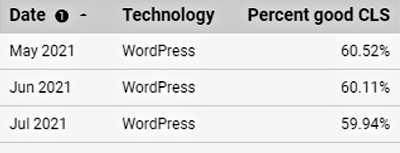

Wix CLS Performance Scores
Wix actually improved their scores by over 7%.
Perhaps even more stunning, while 59.94% of WordPress publishers have a passing CLS score in July, a whopping 80.49% of Wix publishers enjoyed a good CLS score.
Screenshot of Wix CLS Scores
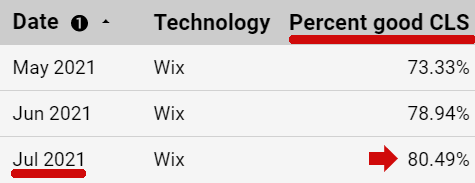

With an over 20 percentage point lead, Wix is the winner in the contest between Wix and WordPress over which offers the best CLS scores.
Advertisement
Continue Reading Below
What Causes Cumulative Layout Shift?
Things like advertisements, images, embedded videos and tweets can cause CLS.
It’s possible that the way publishers use WordPress is responsible for the significantly poorer CLS performance compared to the Wix platform.
Overall CWV Performance: WordPress Versus Wix
WordPress CWV Performance Improvement
The report shows that WordPress is steadily improving its CWV performance but at a modest pace of only 1% per month.
WordPress improved by only 2% between May and July 2021.
The following are the percentages of websites published with WordPress that received good scores.
WordPress CWV Performance
- May 2021 17.1%
- June 2021 18.9%
- July 2021 19.1%
Screenshot of WordPress CWV Scores
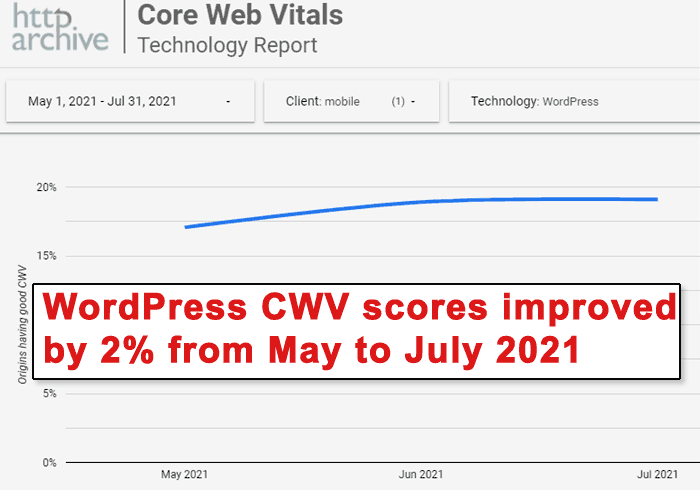

Wix CWV Performance Improvement
Wix showed impressive improvement between May and July 2021, achieving a six percentage point improvement between May and July 2021.
Advertisement
Continue Reading Below
The following are the Wix Performance Metrics:
- May 2021 22.6%
- June 2021 28.3%
- July 2021 28.5%
Screenshot of Wix Core Web Vitals Scores
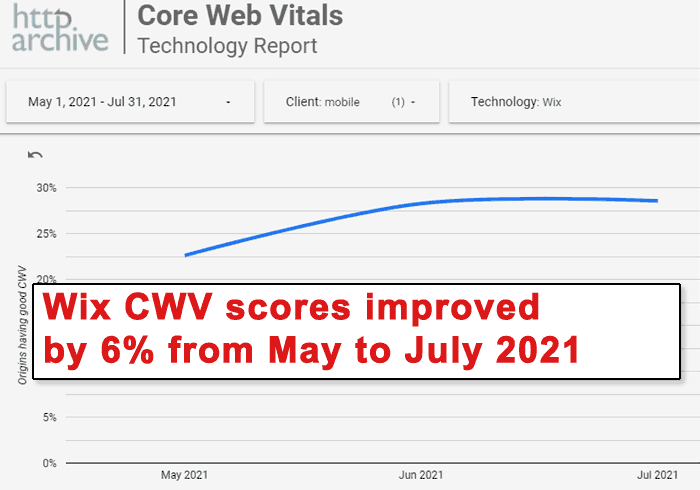

For the overall Core Web Vitals scoring, Wix leads WordPress by 9 percentage points.
WordPress’ poor CLS performance (relative to Wix’s significantly higher scores) dragged down the overall CWV score for WordPress.
Facts are Clear: Wix Has Higher CWV Scores
In the overall Core Web Vitals score, Wix leads WordPress by 9 percentage points.
Advertisement
Continue Reading Below
Facts are facts: More publishers on the Wix platform achieve overall good Core Web Vitals scores than publishers using WordPress.
For the month of July 2021, 19.1% of WordPress publishers achieved good CWV scores while 28.5% of Wix publishers enjoyed good CWV scores.
That’s a nearly ten percentage point better performance of Wix over WordPress.
The Wix approach to managing their web technology may have an advantage over WordPress because Wix is able to control and tune each web page element so that the website can perform to their standards.
WordPress is an open source content management system (CMS) with thousands of third party developers who contribute themes and plugins that may negatively affect the page experience performance.
Wix is Improving at a Fast Pace
The Wix approach to proprietary closed system shows a faster rate of improvement than WordPress. From May to July, the Wix Core Web Vitals scores jumped by six percentage points, going from 22.6% to 28.5%.
WordPress experienced an improvement but that improvement was by a modest two percentage points, crawling from 17.1% in May to a modestly better 19.1% improvement in July.
Advertisement
Continue Reading Below
Again it must be said that because WordPress is an open source system, individual publishers can create websites with faster performance scores than Wix. Publishers on the Wix platform don’t have the freedom to improve their performance scores.
But in the Wix publishing ecosystem, having little control over web performance is feature and not a bug for publishers who want to focus on business and not on babysitting the underlying technology.
Wix Wins… But Not By Much
Clearly the faster pace of improvement in CWV scores shows that the Wix approach has advantages for certain publishers.
But WordPress is not that far behind.
The contest for Core Web Vitals excellence continues.
Citation
Announcement Tweet by Rick Viscomi
I’ve updated the Core Web Vitals Technology Report to include the July data from CrUX and HTTP Archive.
Looking specifically at desktop experiences, the Shopify/Squarespace/Wix saga intensifies 🤠🍿https://t.co/MdS1nCAFTX pic.twitter.com/5yJzsXjev5
— Rick Viscomi (@rick_viscomi) August 10, 2021
Facebook Faces Yet Another Outage: Platform Encounters Technical Issues Again

Uppdated: It seems that today’s issues with Facebook haven’t affected as many users as the last time. A smaller group of people appears to be impacted this time around, which is a relief compared to the larger incident before. Nevertheless, it’s still frustrating for those affected, and hopefully, the issues will be resolved soon by the Facebook team.
Facebook had another problem today (March 20, 2024). According to Downdetector, a website that shows when other websites are not working, many people had trouble using Facebook.
This isn’t the first time Facebook has had issues. Just a little while ago, there was another problem that stopped people from using the site. Today, when people tried to use Facebook, it didn’t work like it should. People couldn’t see their friends’ posts, and sometimes the website wouldn’t even load.
Downdetector, which watches out for problems on websites, showed that lots of people were having trouble with Facebook. People from all over the world said they couldn’t use the site, and they were not happy about it.
When websites like Facebook have problems, it affects a lot of people. It’s not just about not being able to see posts or chat with friends. It can also impact businesses that use Facebook to reach customers.
Since Facebook owns Messenger and Instagram, the problems with Facebook also meant that people had trouble using these apps. It made the situation even more frustrating for many users, who rely on these apps to stay connected with others.
During this recent problem, one thing is obvious: the internet is always changing, and even big websites like Facebook can have problems. While people wait for Facebook to fix the issue, it shows us how easily things online can go wrong. It’s a good reminder that we should have backup plans for staying connected online, just in case something like this happens again.
NEWS
We asked ChatGPT what will be Google (GOOG) stock price for 2030

Investors who have invested in Alphabet Inc. (NASDAQ: GOOG) stock have reaped significant benefits from the company’s robust financial performance over the last five years. Google’s dominance in the online advertising market has been a key driver of the company’s consistent revenue growth and impressive profit margins.
In addition, Google has expanded its operations into related fields such as cloud computing and artificial intelligence. These areas show great promise as future growth drivers, making them increasingly attractive to investors. Notably, Alphabet’s stock price has been rising due to investor interest in the company’s recent initiatives in the fast-developing field of artificial intelligence (AI), adding generative AI features to Gmail and Google Docs.
However, when it comes to predicting the future pricing of a corporation like Google, there are many factors to consider. With this in mind, Finbold turned to the artificial intelligence tool ChatGPT to suggest a likely pricing range for GOOG stock by 2030. Although the tool was unable to give a definitive price range, it did note the following:
“Over the long term, Google has a track record of strong financial performance and has shown an ability to adapt to changing market conditions. As such, it’s reasonable to expect that Google’s stock price may continue to appreciate over time.”
GOOG stock price prediction
While attempting to estimate the price range of future transactions, it is essential to consider a variety of measures in addition to the AI chat tool, which includes deep learning algorithms and stock market experts.
Finbold collected forecasts provided by CoinPriceForecast, a finance prediction tool that utilizes machine self-learning technology, to anticipate Google stock price by the end of 2030 to compare with ChatGPT’s projection.
According to the most recent long-term estimate, which Finbold obtained on March 20, the price of Google will rise beyond $200 in 2030 and touch $247 by the end of the year, which would indicate a 141% gain from today to the end of the year.
Google has been assigned a recommendation of ‘strong buy’ by the majority of analysts working on Wall Street for a more near-term time frame. Significantly, 36 analysts of the 48 have recommended a “strong buy,” while seven people have advocated a “buy.” The remaining five analysts had given a ‘hold’ rating.
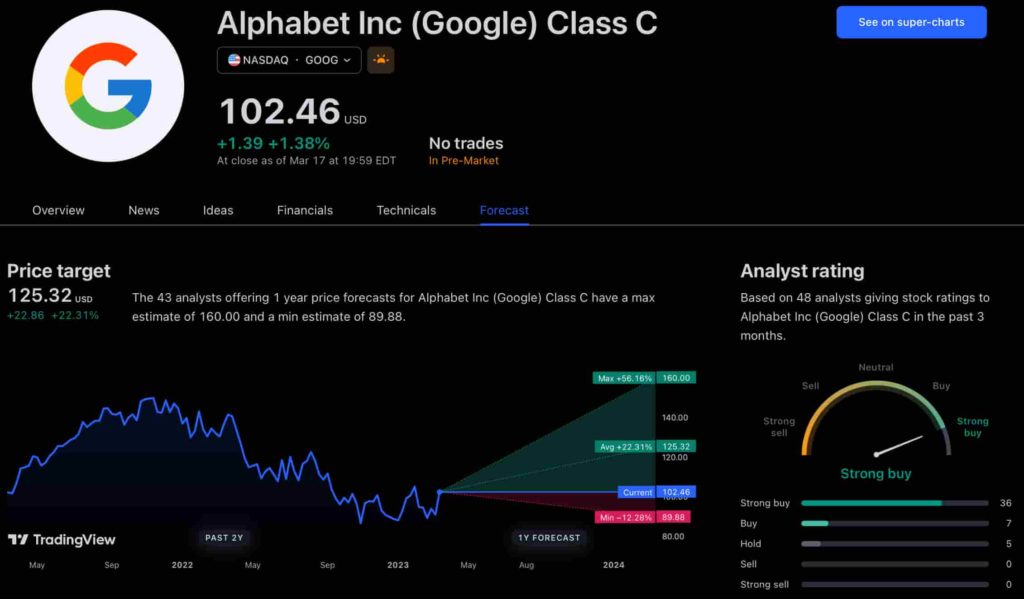
The average price projection for Alphabet stock over the last three months has been $125.32; this objective represents a 22.31% upside from its current price. It’s interesting to note that the maximum price forecast for the next year is $160, representing a gain of 56.16% from the stock’s current price of $102.46.
While the outlook for Google stock may be positive, it’s important to keep in mind that some potential challenges and risks could impact its performance, including competition from ChatGPT itself, which could affect Google’s price.
Disclaimer: The content on this site should not be considered investment advice. Investing is speculative. When investing, your capital is at risk.
NEWS
This Apple Watch app brings ChatGPT to your wrist — here’s why you want it

ChatGPT feels like it is everywhere at the moment; the AI-powered tool is rapidly starting to feel like internet connected home devices where you are left wondering if your flower pot really needed Bluetooth. However, after hearing about a new Apple Watch app that brings ChatGPT to your favorite wrist computer, I’m actually convinced this one is worth checking out.
-
SEARCHENGINES5 days ago
Daily Search Forum Recap: May 3, 2024
-

 MARKETING5 days ago
MARKETING5 days agoHow Tagging Strategies Transform Marketing Campaigns
-

 MARKETING7 days ago
MARKETING7 days agoLet’s Start Treating Content More Like We Treat Code
-

 MARKETING6 days ago
MARKETING6 days agoTinuiti Recognized in Forrester Report for Media Management Excellence
-

 WORDPRESS6 days ago
WORDPRESS6 days agoThe Top 5 AI-Powered Tools for WordPress Creatives – WordPress.com News
-

 PPC6 days ago
PPC6 days agoStandard Performance Max vs Performance Max for Retail
-

 SEO6 days ago
SEO6 days agoGoogle Performance Max For Marketplaces: Advertise Without A Website
-

 SEARCHENGINES4 days ago
SEARCHENGINES4 days agoThe Industry Mourns The Loss Of Mark Irvine













